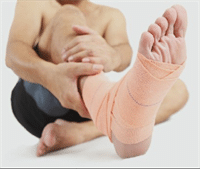
Ankle sprains are a common injury, not just for athletes but in daily life. Legos, curbs, potholes, etc all have been accused of causing an ankle sprain. Regardless of how it happens, the effects are still the same – the ligaments around the ankle are either stretched or torn, and the ankle swells and becomes painful to walk on. We will cover the typical steps following an ankle sprain, but remember recovery varies person to person so it is important to see a health professional to ensure you take the correct steps.
Immediately following an ankle sprain there is typically pain and swelling. This is your body’s way of reacting and sending healing nutrients to the site. Inflammation is a part of recovery in the early stages. New research has shown that icing an ankle sprain can actually delay healing due to the need for the blood flow. Ice would only be beneficial if pain is too severe to manage daily activities. In the early stages the most important thing to do is rest to protect the ankle from further damage. Crutches are not always necessary, but slower walking may be needed.
In the beginning after a sprain a physical therapist can assess the damage and which ligaments are affected as well as making sure no red flags are present such as a fracture to one of the bones that make up the ankle joint. Once pain has diminished, we can start slowly building up the strength around the joint. Ligaments are different from muscles and tendons in that their length is not designed to change. They are supposed to hold bones in place, while the muscles move around them. If the ligament has been stretched with a sprain, the bone may move more than it should. That is why it is important to retrain the muscles around the joint to better stabilize and support the ligaments.
There are many tools and techniques we can use as physical therapists to assist with this. Single leg balance is a key component to ensuring long term health of the ankle. Progressing from stable to unstable surfaces and eventually to eyes closed allows the body to further stabilize the ankle joint. Strengthening will include calf raises and various other moves to allow the muscles to support the joint as well for long term health. Most people can fully recover without any long term issues, but without taking the proper steps chronic inflammation and arthritis can develop. Speak with your physical therapist if you have any questions or concerns.
This video shows Andrew a high school basketball player recovering from a severe ankle sprain. These are a few of the agility exercises that we could incorporate into PT.
Categorized as: Ankle & Foot,Sports Injury